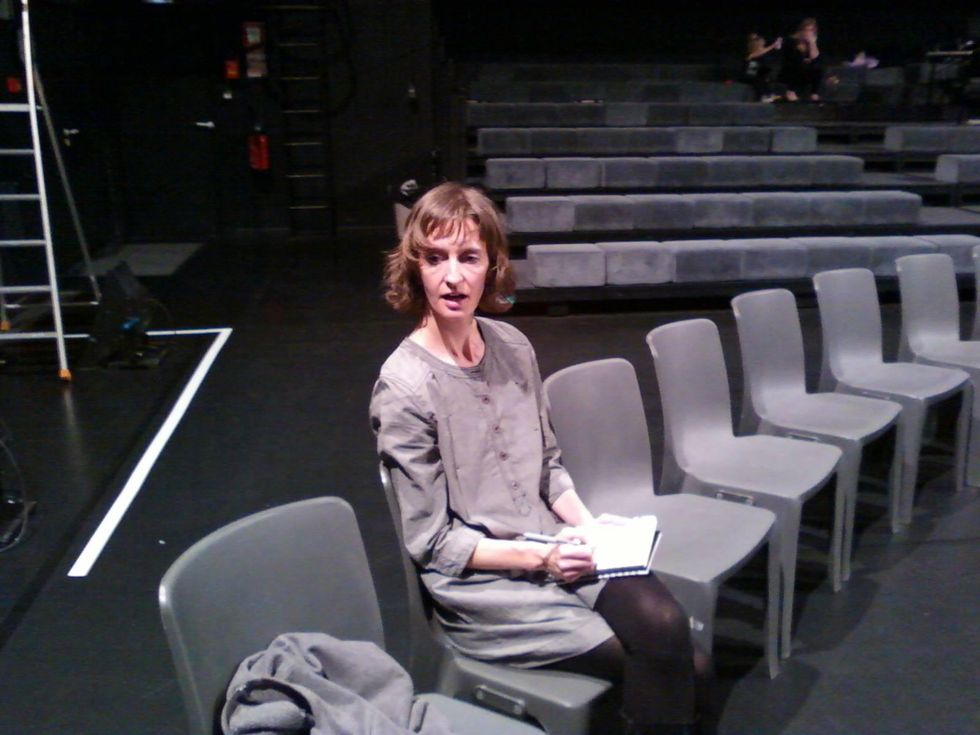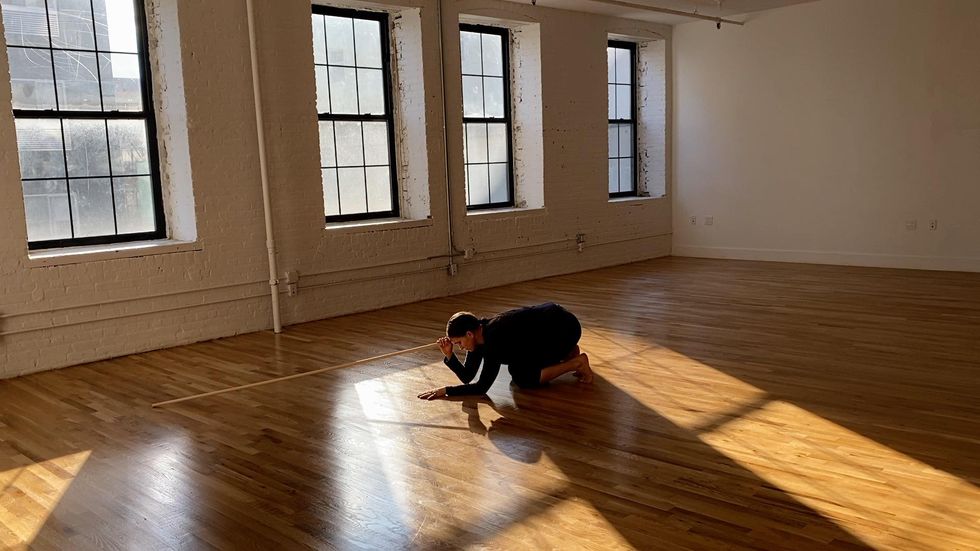Give Artists a Home
When the world as we knew it came to a wild halt in March, I felt like I’d slammed up against the wall of life. Suddenly, I was forced to take a good hard look at the ways I’d been flying forward without ground beneath my feet. COVID-19 unearthed many painful truths about being a dance artist in the U.S. Most pressing: the utter precariousness of it.
The constant travel I’d been doing pre-pandemic made me believe that I was “getting somewhere,” pouring a kind of concrete around my career that would eventually breed roots in the form of a “home” for my work: a sign of stability and future. And yet, quarantine illuminated the harsh reality that a solid foundation was not, in fact, forming. The travel was only masking the reality that I didn’t have any kind of real home for my creative practice.
There are many places in our country to “make work.” Studios to rent. Residencies of varying length and scope where we can disappear temporarily into our process. But do we really belong anywhere? For me, this question resonates differently now than it did when I was still defined as an “emerging artist.” Now I want deeper roots. I want resources that would allow me to support dancers long-term, build communities and create a sense of future.
“Where’s my artistic home?” I asked myself.
An artistic home can mean many things, the most literal being physical work spaces like New York City Ballet’s theater in Lincoln Center or the studios of the San Francisco–based ODC/Dance, which was the first modern-dance company in the U.S. to build its own facility. There’s the creative pairing of Bill T. Jones/Arnie Zane Company and New York Live Arts, and the residencies that give artists a long-term relationship there. A home can be a set of principles or commitments which allow an artist to feel “at home” enough to be confident that their work has value. Or a live/work space like the lofts that choreographers like Lucinda Childs and Douglas Dunn bought in the ’70s. In our gig economy, a full-time salary can provide a sense of security akin to a home.
Stretched across the U.S. there exist many kinds of artistic homes of diverse scale. So, why do so many of us feel homeless when it comes to our work? And how does that affect our sense of belonging and longevity?
In 2011, I started working on a dream to cultivate an artistic home. I’d been given a residency at the Centre Chorégraphique National (CCN) de Franche-Comté à Belfort in France, and for an entire month, I had a home for my work and life. I’ll never forget my breathless awe when our host, Laurent Vinauger, now the dance delegate for the Ministry of Culture in Paris, opened the theater doors and said: “This is yours.” In that first week, the New York City stress drained out of my body so that, in subsequent weeks, I could access something deeper. It’s the feeling we often get when we enter our domestic spaces, shut the door, and breathe differently.

Bartosik at CCN Belfort
Courtesy Bartosik
I decided that over the next 10 years, I wanted to become an artistic director of one of the 19 CCNs in France. The French government created these facilities in 1984 to decentralize art-making from Paris and to give artists longer-term support. Today, they offer artistic directors up to 10 years (and sometimes longer) of artistic housing over a series of renewable contracts. The positions come with a space to create work along with a mandate to designate a percentage of their budget to serve their communities and support guest residencies.
It’s nine years into my 10-year plan, and not only do I not have a CCN job, I’ve never had another residency of that length and depth. And even with the grants, honors and commissions I’ve gratefully received, I have never come close to having enough resources to share with others.
As a choreographer, the closest I’ve come in New York City to feeling like I had temporary housing was as a New York Live Arts Live Feed artist (2017–20). The practical resources were essential, but the relationships to the people and place were the most valuable asset. I felt I belonged somewhere. When my Live Feed project, through the mirror of their eyes, closed on March 7, the day before New York City began to shut down, the reality that this lifeline was gone (although some relationships continue, the tangible sense of “home” disappeared) created a huge hole in my sense of future, deepening the feeling of isolation we all plunged into during the pandemic.
It’s easy to assume that lack of funding is the reason so few U.S. dance artists have anything close to an artistic home. I’d argue that yes, money rules, but the reasons are more complicated, deeply cultural. We are a country that values individual success and prizes giving to get something back. (After all, our philanthropic model is based on charitable donations to receive a tax break.)
As artists, it can be hard to help others when we never feel we have enough for ourselves. Our awareness that there’s no one who “has our back” can make this profession feel like a wild game of “Survivor.” On my darker days, I feel the weight of that. On days with hope, I imagine a future that values artists as essential citizens, where we can afford to value each other in the form of material support.
In this historical moment of extreme turmoil, my plea is to rebuild a world where housing has many meanings. Where funders support an artist’s life to the extent that there are mandates to support others, in whatever way that manifests. If we can’t feed each other, the tables inside our homes will feel hopelessly empty.
Many Kinds of Artistic Homes
Writing this in what feels like the ashes of our arts industry, what does the plea “Give artists a home” even mean? I recently spoke to a few colleagues who have created some form of artistic home. Their diverse experiences range from having a connection to an arts community to actively putting money into people or brick-and-mortar buildings. Each artist’s vision reflects different realities, yet they have all been able to expand their practice and fuel a more viable future.
RoseAnne Spradlin

Maria Baranova, Courtesy Spradlin
The Randjelovic´/Stryker Resident Commissioned Artist program at New York Live Arts is a highly coveted opportunity for mid-career artists. Over the course of a two-year residency, RCAs receive a salary, health benefits, a commission of a new work and access to staff expertise around fundraising, financial literacy and other essential skills.
With the RCA resources, New York City–based choreographer RoseAnne Spradlin (RCA 2017–18) created Y on a cast of eight, a scale new to her. “I did feel it was a home,” she says, even if it was a temporary one. While Spradlin admits that she felt welcomed post-residency, “it wasn’t the same.” Time moves on. Home ownership changes.
Kyle Abraham
Choreographer Kyle Abraham is a potent example of what large-scale, individual artist funding can do to nourish an ecosystem. Rather than buying a personal home for himself with the support he received between 2012 and 2016 (including, among others, the MacArthur “genius” grant and the Live Arts RCA), he began building a kind of home in the form of steady work and health care for his dancers. A.I.M now employs a company of eight, plus four staff members, for 52 weeks a year with vacation. A.I.M dancers have a place to grow, mature, thrive, fail, get sick or injured, and still have a job.
It wasn’t always like this for Abraham. “There was a time when I was on food stamps,” he says, where, during residency, he would use his food stamp allotment to pay for the company’s meals.

Tatiana Willis, Courtesy Abraham
Abraham recognizes that his journey is unique in this era when most artistic directors have purposefully avoided the traditional company model, for fear of not being able to successfully navigate the financial and administrative strains. Even with all his success, he is clear, however, that A.I.M doesn’t replace “home” or “family” in the deeper sense. “The more established a company like mine becomes, the more separate I am from a sense of family.”
Bill Young

Bill Young with his wife Colleen Thomas at 100 Grand
Julia Discenza, Courtesy Young
Choreographer Bill Young paid the down payment on 100 Grand Street in New York City in 1985. Originally, this airy SoHo loft functioned as a place where he lived and played/worked with other dance artists. In 2004, he married fellow choreographer Colleen Thomas, and by the time the two started a family (they have two children), the rising costs of the loft made it necessary to rent out the living quarters.
His relationship to the place had also changed. “By the time I’ve had a rehearsal all day, all I want to do is get out of there!” he says. He still rehearses daily at 100 Grand. The separation has been highly beneficial: He now relishes going home after work, and continues to make his loft affordable for other dance artists to rent.
Bebe Miller
Brooklyn-born Bebe Miller had an epiphany one night in 1994, nine years after forming her dance company. On an evening walk during an out-of-town gig, she paused, noticing the light of the moon on the snowy ground and thought: Maybe it’s time to leave New York.
Five years later, she started building a life in Columbus, Ohio, where a full professorship was offered to her in the dance department of Ohio State University, her alma mater. She wanted “a porch and a garden” and, among other things, “a locker.” (Ah, the choreographer’s pain of dragging props and sets throughout the subway!)

Courtesy Miller
The distance from her company changed her creative momentum but not the depth of her process. “It took me a while to recognize that I left a way of working,” she says. Scheduling two- to three-week residencies at OSU, she was able to create a home away from home for her company and to work with seasoned dancers from outside New York. “The living in the work,” she says, “became a really different kind of experience…really rich.”

Courtesy Sperber
Anna Sperber
Sunset Space was choreographer Anna Sperber’s artistic home for just over a year before the pandemic forced her to give up her lease. This quiet Brooklyn studio was Sperber’s second long-term studio lease. The first, BRAZIL, which she leased from 2005 to 2014, was a rehearsal and performance space for her own work that she also rented out at an affordable rate to colleagues and other artists.
“It really was like a home,” she says, “and I think it was like a home for other people too. I never made a profit but almost broke even.”
Once it’s safe to gather again—and there’s a broader understanding of how the pandemic has changed the realities facing New York’s performing arts community—Sperber hopes to think about what her next artistic home might look like.
Jonah Bokaer
For the past 18 years, choreographer/performer Jonah Bokaer has been dedicated to providing “homes for dance” in the form of viable work spaces. In 2002 he founded Brooklyn’s Chez Bushwick, and its success led, in 2009, to building the Center for Performance Research with co-founder John Jasperse.
The idea for CPR arose from Bokaer’s interest in “cracking the economic pandemic of New York, New York City, the U.S.,” and asking the existential question: “Does NYC want artists to have homes? Does NYC want artists to stay?” Seven years later, he founded Space 428 in Hudson, New York, in a former church that he had purchased partly with his 2015 United States Artists Award and has since renovated into a live/work/event space.
Bokaer’s path is intrinsically tied to being born to a refugee Tunisian father who had six kids and went through bankruptcy. He says migration and belonging were huge topics in his family. In response, he has spent his adulthood creatively problem-solving with an almost unheard of ability to balance structural economics and placemaking.

Mark Poucher, Courtesy Jonah Bokaer Arts Foundation






